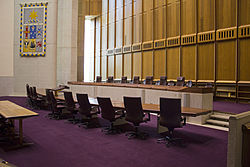
The High Court of Australia is the apex court of the Australian legal system. It exercises original and appellate jurisdiction on matters specified in the Constitution of Australia and supplementary legislation.

The Australia Act 1986 is the short title of each of a pair of separate but related pieces of legislation: one an act of the Parliament of Australia, the other an act of the Parliament of the United Kingdom. In Australia they are referred to, respectively, as the Australia Act 1986 (Cth) and the Australia Act 1986 (UK). These nearly identical Acts were passed by the two parliaments, because of uncertainty as to whether the Commonwealth Parliament alone had the ultimate authority to do so. They were enacted using legislative powers conferred by enabling Acts passed by the parliaments of every Australian state. The Acts came into effect simultaneously, on 3 March 1986.

R v Kirby; Ex parte Boilermakers' Society of Australia, known as the Boilermakers' Case, was a 1956 decision of the High Court of Australia which considered the powers of the Commonwealth Court of Conciliation and Arbitration to punish the Boilermakers' Society of Australia, a union which had disobeyed the orders of that court in relation to an industrial dispute between boilermakers and their employer body, the Metal Trades Employers' Association.

The legal system of Australia has multiple forms. It includes a written constitution, unwritten constitutional conventions, statutes, regulations, and the judicially determined common law system. Its legal institutions and traditions are substantially derived from that of the English legal system. Australia is a common-law jurisdiction, its court system having originated in the common law system of English law. The country's common law is the same across the states and territories.
The separation of powers in Australia is the division of the institutions of the Australian government into legislative, executive and judicial branches. This concept is where legislature makes the laws, the executive put the laws into operation, and the judiciary interprets the laws; all independently of each other. The term, and its occurrence in Australia, is due to the text and structure of the Australian Constitution, which derives its influences from democratic concepts embedded in the Westminster system, the doctrine of "responsible government" and the United States version of the separation of powers. However, due to the conventions of the Westminster system, a strict separation of powers is not always evident in the Australian political system, with little separation between the executive and the legislature, with the executive required to be drawn from, and maintain the confidence of, the legislature; a fusion.
Section 51(i) of the Australian Constitution enables the Parliament of Australia to make laws about:
Australian administrative law defines the extent of the powers and responsibilities held by administrative agencies of Australian governments. It is basically a common law system, with an increasing statutory overlay that has shifted its focus toward codified judicial review and to tribunals with extensive jurisdiction.
In Australian constitutional law, chapter III courts are courts of law which are a part of the Australian federal judiciary and thus are able to discharge Commonwealth judicial power. They are so named because the prescribed features of these courts are contained in chapter III of the Australian Constitution.

The Administrative Appeals Tribunal (AAT) is an Australian tribunal that conducts independent merits review of administrative decisions made under Commonwealth laws of the Australian Government. The AAT review decisions made by Australian Government ministers, departments and agencies, and in limited circumstances, decisions made by state government and non-government bodies. They also review decisions made under Norfolk Island laws. It is not a court and not part of the Australian court hierarchy; however, its decisions are subject to review by the Federal Court of Australia and the Federal Circuit Court of Australia. The AAT was established by the Administrative Appeals Tribunal Act 1975 and started operation in 1976.

The Supreme Court of Norfolk Island is the superior court for the Australian territory of Norfolk Island. It has unlimited jurisdiction within the territory in civil matters and hears the most serious criminal matters. It also has jurisdiction over the Coral Sea Islands Territory. All matters are heard before a single judge, including appeals from the Court of Petty Sessions. In the Australian court hierarchy, it is one of eight state and territory Supreme Courts having unlimited jurisdiction in their respective parts of Australia. Appeal lies to the Federal Court of Australia, from which an appeal by special leave can be made to the High Court of Australia.

The Federal Court of Australia is an Australian superior court which has jurisdiction to deal with most civil disputes governed by federal law, along with some summary and indictable criminal matters. Cases are heard at first instance mostly by single judges. In cases of importance, a full court comprising three judges can be convened upon determination by the Chief Justice. The Court also has appellate jurisdiction, which is mostly exercised by a Full Court comprising three judges, the only avenue of appeal from which lies to the High Court of Australia. In the Australian court hierarchy, the Federal Court occupies a position equivalent to the supreme courts of each of the states and territories. In relation to the other courts in the federal stream, it is superior to the Federal Circuit and Family Court of Australia for all jurisdictions except family law. It was established in 1976 by the Federal Court of Australia Act.

In most legal jurisdictions, a supreme court, also known as a court of last resort, apex court, and highcourt of appeal, is the highest court within the hierarchy of courts. Broadly speaking, the decisions of a supreme court are binding on all other courts in a nation and are not subject to further review by any other court. Supreme courts typically function primarily as appellate courts, hearing appeals from decisions of lower trial courts, or from intermediate-level appellate courts. A Supreme Court can also, in certain circumstances, act as a court of original jurisdiction, however, this is typically limited to constitutional law.

The Court of Disputed Returns in Australia is a special jurisdiction of the High Court of Australia. The High Court, sitting as the Court of Disputed Returns, hears challenges regarding the validity of federal elections. The jurisdiction is twofold: (1) on a petition to the Court by an individual with a relevant interest or by the Australian Electoral Commission, or (2) on a reference by either house of the Commonwealth Parliament. This jurisdiction was initially established by Part XVI of the Commonwealth Electoral Act 1902 and is now contained in Part XXII of the Commonwealth Electoral Act 1918. Challenges regarding the validity of State elections are heard by the Supreme Court of that State as the State's Court of Disputed Returns.

Kirmani v Captain Cook Cruises Pty Ltd , was a decision of the High Court of Australia on 17 April 1985 concerning section 74 of the Constitution of Australia. The Court denied an application by the Attorney-General of Queensland seeking a certificate that would permit the Privy Council to hear an appeal from the High Court's decision in Kirmani v Captain Cook Cruises Pty Ltd .

Deakin v Webb was one of a series of cases concerning whether the States could tax the income of a Commonwealth officer. The High Court of Australia overruled a decision of the Supreme Court of Victoria, holding that the States could not tax the income of a Commonwealth officer. This resulted in conflict with the Privy Council that was ultimately resolved by the passage of Commonwealth law in 1907 to permit the States to tax the income of a Commonwealth officer. The constitutional foundation of the decision was overturned by the subsequent decision of the High Court in the 1920 Engineers' Case.

Baxter v Commissioners of Taxation (NSW), and Flint v Webb, were the last of a series of cases concerning whether the States could tax the income of a Commonwealth officer which had resulted in conflict between the High Court and the Privy Council. The two cases were heard together, however two separate judgments were issued with Baxter v Commissioners of Taxation (NSW) addressing the substantive issues, and Flint v Webb addressing the applications for a certificate to appeal to the Privy Council. The judgement of Griffith CJ in Flint v Webb suggested two ways in which that conflict could be resolved. Both suggestions were adopted by the Commonwealth Parliament by legislation that permitted the States to tax the income of a Commonwealth officer, and gave the High Court exclusive appellate jurisdiction on such constitutional questions. The constitutional foundation of the decision was overturned by the subsequent decision of the High Court in the 1920 Engineers' case.

The Commonwealth Industrial Court, known as the Australian Industrial Court from 1973, was a specialist court to deal with industrial matters, principally the enforcement of awards and orders of the Commonwealth Conciliation and Arbitration Commission. Over time it took on more matters and its judges were allocated a wide range of judicial tasks until it was replaced in 1977 by the Federal Court of Australia which had a more general jurisdiction covering matters arising under Australian federal law.

SS Kalibia v Wilson, was the first decision of the High Court of Australia on the extent of the power of the Australian Parliament to make laws about shipping and navigation, including the Admiralty jurisdiction of the High Court. The High Court held that the power was limited to overseas and interstate trade and commerce. There was no separate power about navigation and shipping.
Judicial independence is regarded as one of the foundation values of the Australian legal system, such that the High Court held in 2004 that a court capable of exercising federal judicial power must be, and must appear to be, an independent and impartial tribunal. Former Chief Justice Gerard Brennan described judicial independence as existing "to serve and protect not the governors but the governed", albeit one that "rests on the calibre and the character of the judges themselves". Despite general agreement as to its importance and common acceptance of some elements, there is no agreement as to each of the elements of judicial independence.
Section 122 of the Constitution of Australia deals with matters relating to the governance of Australian territories. It gives the Commonwealth Parliament complete legislative power over the territories. This power is called the territories power. The extent and terms of the representation of the territories in the House of Representatives and the Senate are also stated as being at the discretion of the Commonwealth Parliament.









